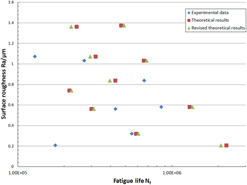Crossref Citations
This article has been cited by the following publications. This list is generated based on data provided by
Crossref.
Xiang, Longhao
Pan, Juyi
Chen, Songying
and
Zhong, Yunpan
2018.
Experimental investigation on the stress corrosion cracking of FV520B welded joint in natural gas environment with ECP and SSRT.
Engineering Fracture Mechanics,
Vol. 200,
Issue. ,
p.
166.
Wang, Jinlong
Yang, Yuxing
Yu, Jing
Wang, Jingsi
Du, Fengming
and
Zhang, Yuanliang
2020.
Fatigue Life Evaluation Considering Fatigue Reliability and Fatigue Crack for FV520B-I in VHCF Regime Based on Fracture Mechanics.
Metals,
Vol. 10,
Issue. 3,
p.
371.
Jinlong, Wang
Yangyang, Yan
Jing, Yu
Jingsi, Wang
Fengming, Du
and
Yuxing, Yang
2020.
Fatigue evaluation of FV520B-I shrouded impeller blade with fatigue crack based on FEA and fracture mechanics.
Engineering Failure Analysis,
Vol. 115,
Issue. ,
p.
104663.
Jinlong, Wang
Jing, Yu
Yuxing, Yang
Fengming, Du
and
Jingsi, Wang
2020.
Study of the remanufacturing critical threshold and remanufacturability evaluation for FV520B-I blade based on fatigue life and FEA.
Engineering Failure Analysis,
Vol. 112,
Issue. ,
p.
104509.
Zhao, Bingfeng
Song, Jiaxin
Xie, Liyang
Hu, Zhiyong
and
Chen, Jianpeng
2021.
Surface roughness effect on fatigue strength of aluminum alloy using revised stress field intensity approach.
Scientific Reports,
Vol. 11,
Issue. 1,
Zhang, Pengfei
Wang, Decheng
Guo, Yu
Cheng, Peng
Shao, Chenxi
Lang, Ning
Liu, Xiaoxiao
and
Huang, Jihua
2021.
Fatigue failure analysis and finite element assessment of the twins torsion spring.
Engineering Failure Analysis,
Vol. 122,
Issue. ,
p.
105187.
Jinlong, Wang
Wenjie, Peng
Jing, Yu
Jingsi, Wang
Mingchao, Ding
and
Yuanliang, Zhang
2021.
Effect of surface roughness on the fatigue failure and evaluation of TC17 titanium alloy.
Materials Science and Technology,
Vol. 37,
Issue. 3,
p.
301.
Jinlong, Wang
Wenjie, Peng
Yongjie, Bao
Yuxing, Yang
and
Chen, Chen
2022.
VHCF evaluation with BP neural network for centrifugal impeller material affected by internal inclusion and GBF region.
Engineering Failure Analysis,
Vol. 136,
Issue. ,
p.
106193.
Saleem, Aleena
Tamura, Hiroshi
and
Katsuchi, Hiroshi
2023.
Development of ultra-low cycle fatigue life prediction model for structural steel considering the effects of surface roughness, loading frequency, and loading amplitude.
Advances in Structural Engineering,
Vol. 26,
Issue. 14,
p.
2749.
Zhang, Youdong
Xiao, Guijian
Zhou, Kun
Zhu, Bao
Gao, Hui
and
Huang, Yun
2023.
Two-Phase fatigue life prediction method based on scSE U-net algorithm for abrasive belt grinding of titanium alloy.
Journal of Materials Processing Technology,
Vol. 319,
Issue. ,
p.
118075.
Jiang, Yang
2023.
Analysis of Influencing Factors on Fatigue Life of a Certain Radar Structure.
Journal of Physics: Conference Series,
Vol. 2578,
Issue. 1,
p.
012036.
Michler, Thorsten
Oesterlin, Heiner
and
Fischer, Carl
2025.
Comparison of low cycle fatigue data of X52 pipeline steel in air and gaseous hydrogen using conventional and hollow specimen.
International Journal of Fatigue,
Vol. 197,
Issue. ,
p.
108939.
